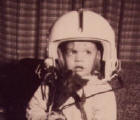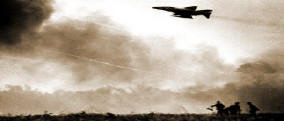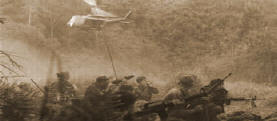



|
|
|
|
Scotty misses Happy Hour at O'Club on October 24, 1986! I have told this story innumerable times through the years. But of course I usually tell this story in person and usually after a couple beers. I don't suppose you want me to send the 35 page Air Force accident report verbatim. I was stationed at Langley AFB, VA flying T-33's attached to an Air Defense Squadron of F-15's. I was not scheduled to fly that Friday afternoon, but got tasked to fly in a supervisory role at the last minute on the wing of a new flight lead. The scenario consisted of the two T-33's simulating Russian Frogfoots to be escorted by four Marine A-4's simulating Fishbeds to attack a target defended by two F-15's simulating F-15's. The A-4's from NAS Oceana would rendezvous with the T-33's (callsign Iceman 45 and 46) in the western edge of warning area 386 (W-386 starts just off the coast and extends about 150 miles offshore). The F-15's would defend an area in the far eastern end of the warning area. Iceman flight joined up with the A-4's at 19,000' and started to push east at about 1300 hours. The plan was for the A-4's to stay at 19,000' in a box formation to lure the F-15's into a fight while the T-33's ramped down to 5,000' in an echelon formation and attack the target undetected. Fight's On- we started our descent accelerating to within 20 knots (about 450 knots) of limiting Mach. Approximately 15 miles from the F-15's and passing 11,000' my world suddenly turned upside down. The airplane had been wings level, 30 degrees nose down when in an instant, without warning, it tucked inverted with about negative 5g's. The accident board determined the negative g's based on the injuries to my eyes (i e. redeye). I didn't see anything after the initial tuck under. I instinctively pulled back on the stick and it came back as if nothing was attached. I felt as if I had just lost the ass-end of the airplane and held on to he stick with a death grip to try to steady myself from the ensuing negative and lateral g forces. I was hanging from the straps getting thrown around violently. I remember hitting my head at least three times very hard against the canopy. The best way to describe it is imagine yourself in a refrigerator tumbling towards the ocean floor. I knew I was a dead-man and my only regret was not being able to see my finance again. I also thought I should have impacted the water by now. Suddenly the airplane or what was left of it swapped ends and instead of negative g's, I had positive g's with wind blast in my face. The positive g's helped force my left hand towards the ejection handle. Without being able to get in the proper body position I squeezed and rotated the left ejection handle. The seat was less violent than the airplane I had just left, but then the opening shock of the parachute felt like it knocked my eyes & teeth out. Because of poor body position I couldn't believe I got out without breaking my neck. I was waving my arms and legs to see what worked (and yelling Thank You GOD) when my vision slowly returned. I could see a blurry horizon and white caps and looking down between my boots I was thinking how close to the water I was when my feet hit the water (the board estimated that I ejected below 1,000' and had a full chute at less than 500'). The weather was clear skies with high winds and 4 to 6 foot sea state. Now I was being dragged on my back by the parachute. I reached up and released from the parachute and immediately sank under water. I pulled the lanyards on my underarm LPU'S and only the right one inflated. I was drowning and to die that way was really going to piss me off, considering I had just escaped an airplane I should have never gotten out of. My one-man raft didn't inflate initially but simply came out of its container un-inflated. By locating the activation cable and pulling on it, I was able to get the raft to inflate. And then struggled to get in the thing. Total time in the water before getting in the raft was about 20 minutes. During the brief we were delighted that the forecast water temp was just above the point where poopy suits were required. Little did I know that in two hours I would have given my left gonad for that poopy suit. I was becoming hypothermic and was in shock and was missing happy hour at the Officers Club. Not the best of days. Once in the raft I attempted contact with the PRC-90 (emergency radio) only to discover my ELT was also inoperative. I was getting prepared to spend the night when radio contact was finally established. A Navy search and rescue helo from Oceana picked me up using a PJ. I spent a little over two hours in the water from ejection to helo pickup. In addition to multiple lacerations, abrasions and contusions, I had second degree burns on my neck that where attributed to ejecting through a fireball. I had a broken left ankle that required surgery and pins. And two compressed vertebra that didn't manifest themselves until a year later when I was pulling 9 g's in the F-16. Believe it or not but I am deleting a lot of details in an attempt to keep this short. The accident board only had me and some survival equipment to work with since the wreckage was about 100 miles offshore in 3,700 feet of water. The most probable conclusion to the reason behind the catastrophic inflight breakup was fuel venting from the sabre drain into the hot tail section. In 1981 a T-33 in the Philippines experienced an almost identical mishap. From the Philippines wreckage it was determined that fuel leaked from the vent line into the tail section and was ignited by the hot tailpipe. The resulting explosion collapsed the tailpipe, blew off the left horizontal stab and began the inflight break-up. The tail section departed and the engine traveled through the fuselage tank and rear cockpit bulkhead section releasing fuel and causing a fireball. As part of the corrective action to the Philippine accident a 300 hour time compliance technical order (TCTO) was issued. This TCTO directed a pressure check of the fuselage fuel vent line every 300 flight hours. The TCTO had been issued in Aug 1981 and it was now Oct 1986 and it was determined that the inspections had never been accomplished at my unit, but had simply been pencil whipped the entire time. That's it in a nutshell. I'm more comfortable telling
aviation stories when I can use my hands as airplanes. I'll save the Desert
Storm stories for the class reunion. That way I'll have something to tell at the
bar. And of course like any good story they only get better with time. Well if
not better they at least get bigger, like a good fishing story. |
|
Select the Help Heff Advertise button for a printable page that you can post at your Work, VA Hospital, VFW Post or other organization. Thank you for any assistance that you can provide! Need a POW-MIA Flag? Want to help a disabled Vet? Click here for more info!
Send mail to
Heffpilot@usaircombat.com with
questions or comments about this web site. |